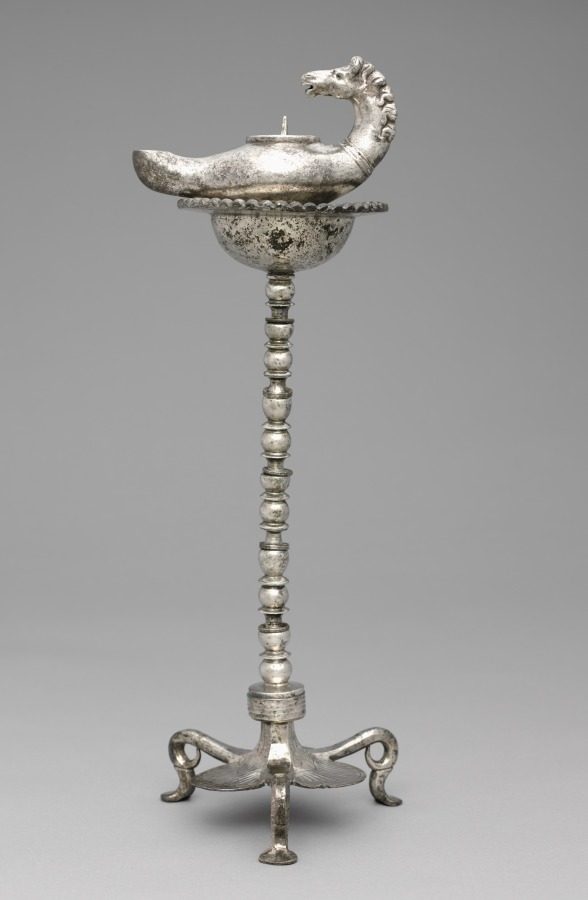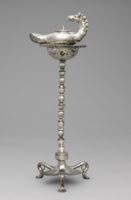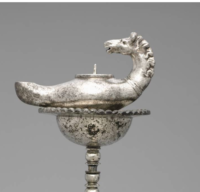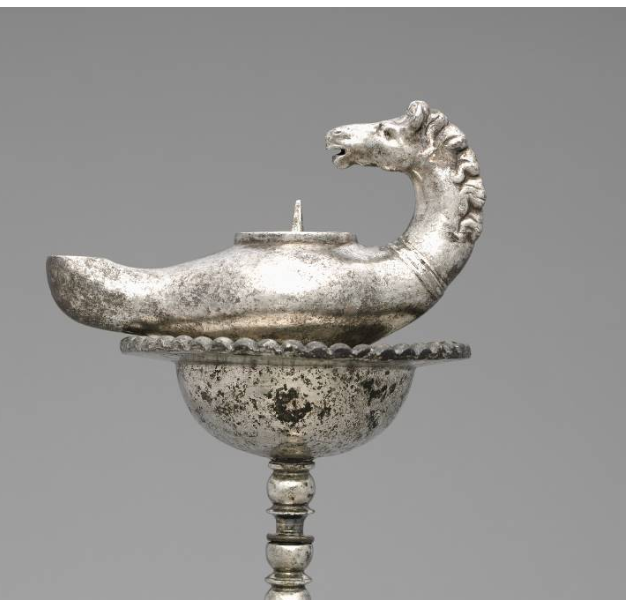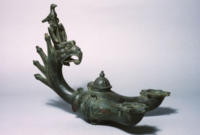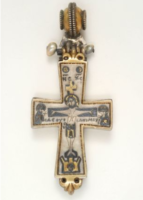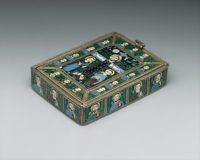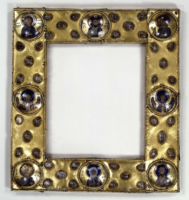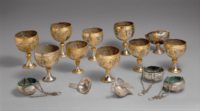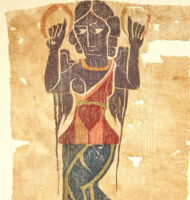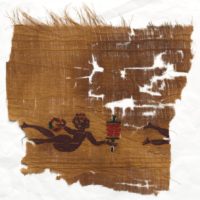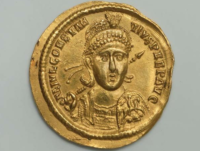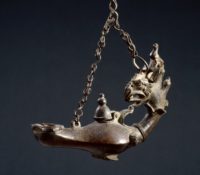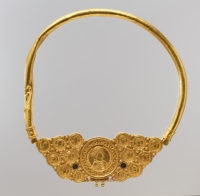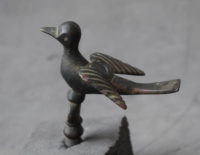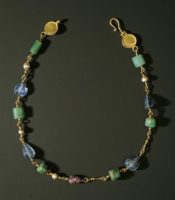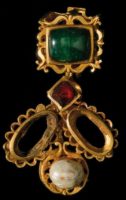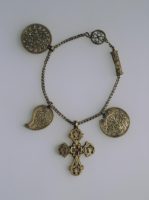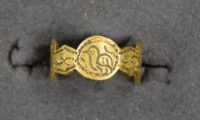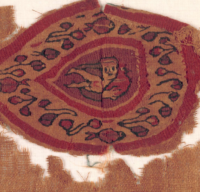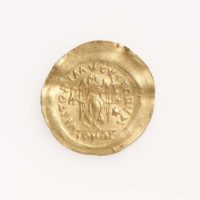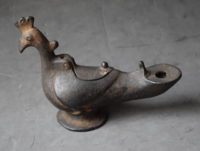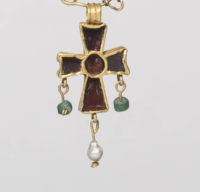Lamp and Stand, Period: Early Byzantine, 4th century. Materials: Silver. 9.2 x 16 x 7 cm (3 9/16 x 6 1/4 x 2 3/4 in.). The Cleveland Art Museum Hours: Tuesdays, Thursdays, Saturdays, Sundays 10:00 a.m.–5:00 p.m. Wednesdays, Fridays 10:00 a.m.–9:00 p.m. Closed Mondays.
Griffin’s Head Lamp, Period: Early Byzantine, circa 4th-5th century. Purchased from George Zacos (dealer), Istanbul by Dumbarton Oaks Research Library and Collection, Washington, DC, July 1962. The museum is open to the public Tuesday through Sunday, 11:30 a.m.–5:30 p.m., except for federal holidays.
Enkolpion Reliquary Cross with Crucifixion and the Virgin, Period: Middle Byzantine, circa 10th to 11th Century A.D. The museum is open to the public Tuesday through Sunday, 11:30 a.m.–5:30 p.m., except for federal holidays.
The Fieschi Morgan Staurotheke, Period: Middle Byzantine, circa: early 9th century, Made in Constantinople, Materials: Gilded silver, gold, enamel worked in cloisonné, and niello. On view at The Met Fifth Avenue in Gallery 303. The Metropolitan Museum of Art (New York) is one of the world’s largest and finest art museums. Its collection includes more than two million works of art spanning five thousand years of world culture, from prehistory to the present and from every part of the globe. Public Hours: 10:30 a.m.–5:30 p.m. Open seven days a week.
Icon Frame, Period: Middle Byzantine, circa: Mid-11th century. Size: 22 x 20 (8.7 x 7.9). Materials: enamel on gilt silver. The museum is open to the public Tuesday through Sunday, 11:30 a.m.–5:30 p.m., except for federal holidays.
The Attarouthi Treasure, Period: Early Byzantine, circa: 500-650s. Made in Attarouthi, Syria. Materials: Silver, silver-gilt. On view at The Met Fifth Avenue in Gallery 300.
These well-wrought liturgical items– chalices, censers, a filter, and also a depiction of the dove of the Holy Spirit– were amongst the belongings of a Christian church in the wealthy seller city of Attarouthi in Syria, after that among the wealthiest lands of the Byzantine Empire. The chalices, censers, and also filter were made use of for the Divine Liturgy, or Eucharist, where Christians take consecrated wine and bread in ceremony of the Last Supper and also Christ’s death. According to their inscriptions, written in Greek with several spelling variants, many of the objects were offerings of local citizens to the major church of the town, which was dedicated to Saint Stephen, and to a smaller church dedicated to Saint John (probably Saint John the Forerunner [the Baptist]). In the very early 7th century Syria dropped initially to the Sasanian Persians and afterwards to the militaries of Islam. These works were most likely hidden in haste in a safety container at some minute when the Byzantine military was pulling away from strikes on the area.
The Metropolitan Museum of Art (New York) is one of the world’s largest and finest art museums. Its collection includes more than two million works of art spanning five thousand years of world culture, from prehistory to the present and from every part of the globe. Public Hours: 10:30 a.m.–5:30 p.m. Open seven days a week.
[xyz-ihs snippet="Met-Museum-Booking"]Coptic Textile fragment, Period: Early Byzantine circa: 4th–6th century A.D. Object Place: Egypt. Materials: Linen plain weave with wool tapestry insert. Dimensions: 34.5 x 65 cm (13 9/16 x 25 9/16 in.).
The MFA is open 7 days a week. Monday and Tuesday 10 am–5 pm, Wednesday–Friday 10 am–10 pm, Saturday and Sunday 10 am–5 pm.
Fragment of a Curtain, Period: Early Byzantine; circa: 5th century. Made in: Egypt, Materials: tabby weave, inwoven tapestry ornament; wool and linen. Dimensions: 23.2 x 22.9 cm (9 1/8 x 9 in.). The Cleveland Art Museum Hours: Tuesdays, Thursdays, Saturdays, Sundays 10:00 a.m.–5:00 p.m. Wednesdays, Fridays 10:00 a.m.–9:00 p.m. Closed Mondays.
Solidus of Constantius II (333–361). Material: Gold. The museum is open to the public Tuesday through Sunday, 11:30 a.m.–5:30 p.m., except for federal holidays.
Lamp for suspension; Period: Early Byzantine. circa: 4thc-5thc. Materials: Brass; the curved handle in the shape of the head and neck of a crested dragon holding an apple in its mouth, and bearing on its head a sacred monogram surmounted by a dove. Subjects:leaf, fruit, dragon and bird. Found Place: Herculaneum, Naples.
Dimensions: Length: 21 centimetresHeight: 15.7 centimetres (lamp)Width: 7.2 centimetresHeight: 41.2 centimetres (including chain)Weight: 1.126 kilograms. British Museum is closed 24, 25 and 26 December and 1 January, but is open every other day of the year. Fast facts about the British Museum: Founded: 1753, Collection size: 8 million objects, Oldest object in the collection: Stone chopping tool (nearly 2 million years old).
Pectoral with Coins and Pseudo-Medallion, Period: Early Byzantine, circa: 539–50, Materials: Gold, niello, On view at The Met Fifth Avenue in Gallery 302. The Metropolitan Museum of Art (New York) is one of the world’s largest and finest art museums. Its collection includes more than two million works of art spanning five thousand years of world culture, from prehistory to the present and from every part of the globe. Public Hours: 10:30 a.m.–5:30 p.m. Open seven days a week.
Bird Figure, Period: Early Byzantine, circa: 6thC-7thC; Made in: Egypt. Dimensions: Height: 2.6 inches. British Museum is closed 24, 25 and 26 December and 1 January, but is open every other day of the year. Fast facts about the British Museum: Founded: 1753, Collection size: 8 million objects, Oldest object in the collection: Stone chopping tool (nearly 2 million years old).
Gold necklace with sapphires, amethysts, emeralds and pearls. Period: Early Byzantine. Place/Findspot: Antinoë in Egypt. The Ravenna mosaics portray this kind of precious jewelry, widespread during Early Christian times, being worn by ladies of the imperial court of Theodora.
The Benaki Museum of Greek Culture is housed in one of the most beautiful neoclassical-style buildings in Athens, near the National Garden and the Hellenic Parliament. It was converted into a museum in order to shelter the collections of Antonis Benakis and was donated to the Greek nation by himself and his three sisters, Alexandra, Penelope and Argine. Following its most recent refurbishment (1989–2000), the building houses a unique exhibition on Greek culture arranged diachronically from prehistory to the 20th century.
Three sections of a Gold necklace. Materials: sapphires, emeralds, cornelians and pearls. Period: Early Byzantine; circa: 5th c. Made in: Alexandria, Egypt. Their height varies from 0.05 to 0.06 m. The Benaki Museum of Greek Culture is housed in one of the most beautiful neoclassical-style buildings in Athens, near the National Garden and the Hellenic Parliament.
Necklace, Period: Early Byzantine, circa: 6th century. Made in Constantinople. Material: gold. Technique: carving, engraving. Dimensions: Lenght 27 cm. The collection of the State Hermitage includes over 3 million works of art and world culture artefacts. It contains paintings, graphic works, sculptures, works of applied art, archaeological artefacts and numismatic objects. The Hermitage is considered to have been founded in 1764, when Empress Catherine the Great acquired an impressive collection of works from the Berlin merchant Johann Ernst Gotzkowsky. The museum celebrates the anniversary of its founding each year on 7 December, St. Catherine’s Day. Opening Hours: Tuesday, Thursday, Saturday, Sunday: 10.30-18.00 Wednesday, Friday: 10.30-21.00 Closed: Monday.
Gold Finger Ring, Period: Early Byzantine (6 th. c.) flat hoop cut into eight alternating circular and hexagonal panels; circular panels engraved alternately with dove and palmette; hexagonal panels with S-shaped line crossed by bar, lines terminating with punched dots. Found/Acquired: Beirut. British Museum is closed 24, 25 and 26 December and 1 January, but is open every other day of the year. Fast facts about the British Museum: Founded: 1753, Collection size: 8 million objects, Oldest object in the collection: Stone chopping tool (nearly 2 million years old).
Fragment from a Curtain, Materials: tabby weave with inwoven tapestry ornament, linen and wool. Period: Early Byzantine circa: 5th – 6th century. The Cleveland Art Museum Hours: Tuesdays, Thursdays, Saturdays, Sundays 10:00 a.m.–5:00 p.m. Wednesdays, Fridays 10:00 a.m.–9:00 p.m. Closed Mondays.
Tremissis of Justinian I, Period: Early Byzantine Period, circa: 552–565 A.D. , Minted in: Ravenna, Material: Gold. The Museum of Fine Arts, Boston is open 7 days a week. Monday and Tuesday 10 am–5 pm, Wednesday–Friday 10 am–10 pm, Saturday and Sunday 10 am–5 pm.
Hanging lamp; Period: Early Byzantine; (5thC-6thC). Found: Tell el-Yahudiya (Africa,Egypt,Lower Egypt,Nile Delta,Tell el-Yahudiya) Length: 6.24 inchesHeight: 4.75 inches. Material: Bronze. British Museum is closed 24, 25 and 26 December and 1 January, but is open every other day of the year. Fast facts about the British Museum: Founded: 1753, Collection size: 8 million objects, Oldest object in the collection: Stone chopping tool (nearly 2 million years old).
Necklace; Materials: Glass and Amber Beads, mall bone cross and a blue faience figure of Bes. Period: 5thc.-6thc, Early Byzantine. Found: Qaw el-Kebir, Upper Egypt. British Museum is closed 24, 25 and 26 December and 1 January, but is open every other day of the year.
Chain with Pendant Cross, Materials: gold, glass, pearl, garnet, and sapphire. Period: Early Byzantine, circa 500s. The Cleveland Art Museum Hours: Tuesdays, Thursdays, Saturdays, Sundays 10:00 a.m.–5:00 p.m. Wednesdays, Fridays 10:00 a.m.–9:00 p.m. Closed Mondays.


